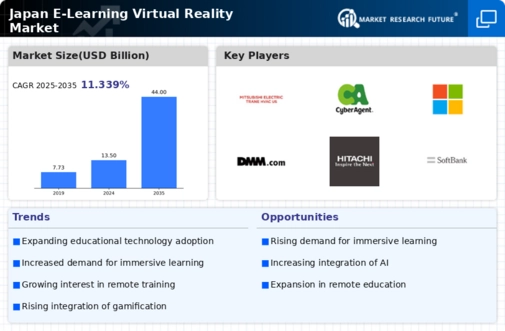Technological Advancements in VR
The e learning-virtual-reality market in Japan is experiencing a surge due to rapid technological advancements in virtual reality (VR) hardware and software. Innovations such as improved graphics, enhanced interactivity, and more immersive experiences are making VR applications more appealing for educational purposes. For instance, the introduction of lightweight VR headsets and more intuitive user interfaces has facilitated broader adoption among educational institutions. As of 2025, the market for VR hardware in education is projected to reach approximately $1.5 billion, indicating a robust growth trajectory. This technological evolution not only enhances the learning experience but also encourages institutions to integrate VR into their curricula, thereby driving the e learning-virtual-reality market forward.
Increased Investment in EdTech Startups
The e learning-virtual-reality market is witnessing a notable increase in investment directed towards EdTech startups in Japan. This trend is fostering innovation and encouraging the development of new VR applications. Venture capital firms and government initiatives are recognizing the potential of VR in transforming educational experiences. In 2025, investments in EdTech are projected to exceed $500 million, with a significant portion allocated to VR-based educational technologies. This influx of capital is fostering innovation and encouraging the development of new VR applications tailored for various educational needs. As startups continue to emerge and expand their offerings, the e learning-virtual-reality market is likely to benefit from enhanced competition and a broader range of solutions, ultimately enriching the educational landscape.
Integration of Gamification in Learning
The integration of gamification strategies within the e learning-virtual-reality market is emerging as a powerful driver in Japan. This trend enhances motivation and engagement among learners. By incorporating game-like elements into educational content, VR applications can enhance motivation and engagement among learners. This trend is particularly appealing to younger audiences, who are more likely to respond positively to interactive and gamified learning experiences. Research indicates that gamified learning can improve retention rates by up to 30%, making it a compelling approach for educators. As more institutions adopt gamification techniques, the e learning-virtual-reality market is likely to see increased investment and development in VR educational tools, further solidifying its role in modern education.
Growing Demand for Remote Learning Solutions
The e learning-virtual-reality market is significantly influenced by the increasing demand for remote learning solutions in Japan. As educational institutions seek to provide flexible learning options, VR technology offers a unique solution that can simulate real-world environments and experiences. This demand is reflected in a survey indicating that over 70% of educators believe that VR can enhance student engagement and understanding. Furthermore, the market is expected to grow at a CAGR of 25% over the next five years, driven by the need for innovative remote learning tools. The ability of VR to create immersive learning experiences positions it as a vital component in the evolving educational landscape, thereby propelling the e learning-virtual-reality market.
Focus on Skill Development and Lifelong Learning
The e learning-virtual-reality market is also being driven by a growing emphasis on skill development and lifelong learning in Japan. As the job market evolves, there is a pressing need for continuous education and upskilling. VR technology provides a unique platform for immersive training experiences that can simulate real-world scenarios, making it particularly effective for vocational training and professional development. According to industry reports, the demand for VR-based training solutions is expected to increase by 40% in the next few years, as companies recognize the value of experiential learning. This focus on skill enhancement is likely to propel the e learning-virtual-reality market, as both educational institutions and corporations invest in VR solutions.

















Leave a Comment